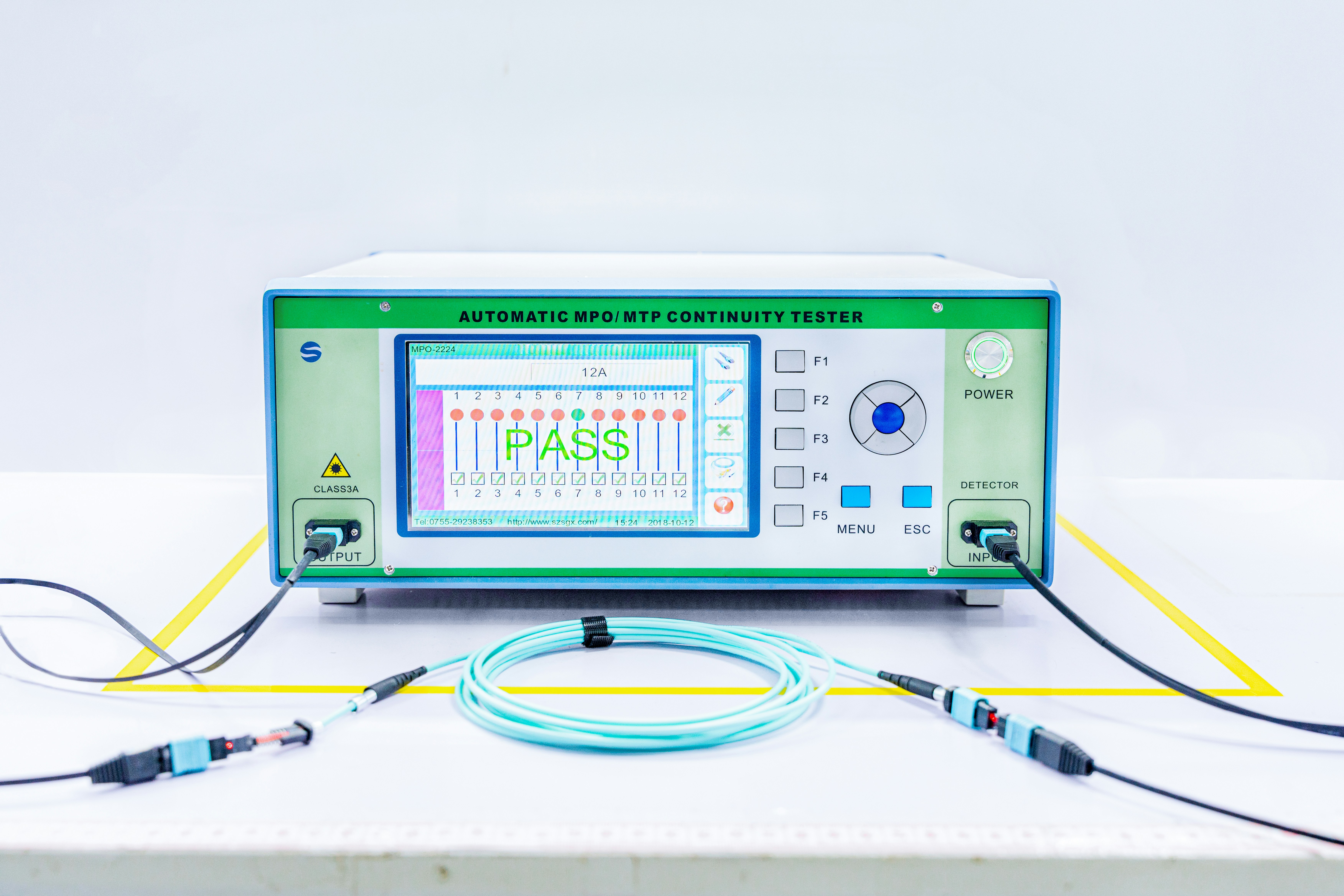5 Essential Fiber Optic Testing and Maintenance Best Practices

Introduction to Fiber Optic Testing and Maintenance
In the world of telecommunications and networking, Fiber Optic technology plays a crucial role in ensuring high-speed data transmission. As these networks become increasingly prevalent, it's essential to understand the significance of Testing and Maintenance. In this blog post, we'll delve into the key aspects of fiber optic testing and maintenance, providing valuable insights for individuals involved in managing or working with fiber optic networks.
Why Fiber Optic Testing and Maintenance Matters
The reliability and efficiency of Fiber Optic networks are directly tied to their proper functioning. Regular Testing allows for the identification of potential issues such as signal loss, physical damage, or connectivity problems. By addressing these issues promptly through effective Maintenance, network downtime can be minimized, ensuring seamless operations for businesses and organizations relying on these networks.
What We'll Cover in This Blog
Throughout this blog, we will cover a comprehensive range of topics related to Fiber Optic Testing and Maintenance. From understanding optical power measurements to the importance of regular signal testing, best practices for network maintenance, and troubleshooting common issues – we aim to provide readers with practical knowledge that can be applied in real-world scenarios. Whether you're a network technician, an IT professional, or simply someone interested in learning more about fiber optics, this blog will equip you with valuable insights into ensuring the optimal performance of fiber optic networks.
Understanding Optical Power Measurements
When it comes to Fiber Optic networks, understanding optical power measurements is crucial for ensuring optimal performance and reliability. Let's delve into the key aspects of this essential practice.
What Are Optical Power Measurements?
In the realm of fiber optics, optical power measurements refer to the process of quantifying the strength of light signals transmitted through the optical fibers. This measurement is vital in assessing the efficiency and integrity of the network's signal transmission capabilities. The basics of measuring light in fiber optics involve utilizing specialized equipment to capture and quantify the intensity of light signals passing through the fibers.
How to Perform Optical Power Measurements
Tools You'll Need
To perform optical power measurements, you will require specific tools designed for accurately capturing and analyzing light signals. These tools typically include an optical power meter, a stable broadband source, and appropriate connectors for seamless integration with the fiber optic network.
Step-by-Step Guide
Begin by connecting the optical power meter to the output port of the broadband source using suitable connectors.
Ensure that both devices are powered on and functioning correctly before proceeding with any measurements.
Position the receiving end of the optical power meter in close proximity to the transmitting end of the fiber optic cable.
Once positioned, initiate a reading on the optical power meter to capture and quantify the intensity of light signals being transmitted through the fiber optic cable.
Optical Power Measurements Best Practices
Keeping Your Equipment Clean
Maintaining cleanliness is paramount when conducting optical power measurements. Any dust or debris present on equipment such as connectors or meters can significantly impact measurement accuracy. Regularly inspecting and cleaning these components ensures consistent and reliable readings.
Regular Calibration
To uphold precision and reliability in your optical power measurements, it's essential to adhere to a regular calibration schedule for your testing equipment. Calibration helps verify that your instruments are providing accurate readings, ultimately contributing to more dependable assessments of your fiber optic network's performance.
By understanding these fundamental aspects of optical power measurements, you can effectively gauge and maintain optimal signal transmission within your fiber optic network.
The Importance of Regular Signal Testing
In the realm of fiber optic networks, signal testing holds immense significance in ensuring the seamless transmission of data and maintaining network integrity. Let's explore the critical aspects of this essential practice.
Signal Testing Explained
Understanding Signal Loss and Its Causes
Signal loss within fiber optic networks refers to the reduction in the strength of transmitted signals as they travel through the optical fibers. This phenomenon can occur due to various factors, including attenuation, dispersion, and macro or micro bends in the fiber. Understanding these causes is crucial for effectively identifying and addressing potential signal loss issues within the network.
Conducting Effective Signal Testing
The Equipment You'll Need
To conduct signal testing effectively, you will require specialized equipment designed to measure signal strength and identify any potential losses. This equipment typically includes an optical time-domain reflectometer (OTDR) and a light source for generating test signals. Additionally, appropriate connectors and cleaning tools are essential for ensuring accurate and reliable testing results.
A Simple Guide to Signal Testing
Begin by preparing the optical time-domain reflectometer (OTDR) and connecting it to one end of the fiber optic cable under test.
Activate the OTDR to initiate signal transmission through the cable, allowing it to capture data regarding signal strength and any losses along the length of the cable.
Analyze the OTDR's output data to identify areas where signal loss occurs, pinpointing potential sources such as splices, connectors, or bends in the fiber.
Utilize this information to assess the overall health of the fiber optic network and address any identified issues promptly.
Signal Testing Best Practices
Frequency of Testing
Regular signal testing is essential for proactively identifying and mitigating potential issues before they escalate into significant network disruptions. Establishing a consistent testing schedule based on factors such as network usage patterns and environmental conditions ensures that any emerging issues are promptly addressed, minimizing downtime and optimizing network performance.
Documenting Your Findings
Maintaining detailed records of signal testing results is paramount for tracking network performance over time. Documenting findings such as signal strengths, losses, and identified issues provides valuable insights into trends and recurring problems within the network. These records also serve as a reference point for future maintenance activities and troubleshooting efforts.
By prioritizing regular signal testing and adhering to best practices, organizations can uphold the reliability and efficiency of their fiber optic networks while minimizing potential disruptions.
Best Practices for Maintenance of Fiber Optic Networks
As we delve into the realm of Fiber Optic networks, it becomes evident that routine Maintenance is pivotal in ensuring the longevity and optimal performance of these intricate systems.
Routine Maintenance Explained
The Role of Visual Inspections
Visual inspections serve as a fundamental aspect of maintenance procedures for fiber optic networks. By conducting regular visual assessments, technicians can identify potential issues such as damaged cables, loose connectors, or environmental factors that may impact network integrity. These inspections provide valuable insights into the physical condition of the network, allowing for prompt intervention to address any identified concerns.
The Importance of Cleaning
Cleaning forms an integral part of routine maintenance for fiber optic networks. Dust, dirt, and other contaminants can accumulate on connectors and cables over time, leading to signal loss and degradation. Implementing a structured cleaning regimen ensures that these components remain free from debris, contributing to sustained network reliability and performance.
Maintenance Best Practices
Creating a Maintenance Schedule
Establishing a comprehensive maintenance schedule is essential for upholding the operational efficiency of fiber optic networks. This schedule should encompass regular visual inspections, cleaning routines, and testing protocols to ensure thorough coverage of all maintenance aspects. By adhering to a predefined schedule, organizations can proactively manage network upkeep while minimizing the risk of unexpected disruptions.
Training Your Team
Equipping your team with the necessary skills and knowledge is paramount for effective maintenance practices within fiber optic networks. Providing comprehensive training on visual inspection techniques, proper cleaning procedures, and testing methodologies empowers technicians to perform their roles with confidence and proficiency. Additionally, staying updated on industry best practices and emerging technologies ensures that your team remains well-prepared to address evolving maintenance requirements.
Troubleshooting Common Fiber Optic Network Issues
In the realm of fiber optic networks, encountering common issues is an inevitable aspect of network management. Understanding these issues and implementing effective troubleshooting practices is essential for maintaining the optimal performance and reliability of these intricate systems.
Identifying Common Issues
Signal Loss
Signal loss represents a prevalent challenge within fiber optic networks, often stemming from factors such as attenuation, dispersion, or physical obstructions along the transmission path. Identifying areas where signal loss occurs is crucial for proactively addressing potential disruptions to data transmission.
Physical Damage
Physical damage to fiber optic cables can result from various environmental factors or inadvertent mishandling during installation or maintenance activities. This damage may manifest as cable breaks, bends, or connector issues, leading to compromised network integrity and performance.
Fiber Optic Network Troubleshooting Steps
Initial Steps for Troubleshooting
When confronted with fiber optic network issues, initiating a systematic troubleshooting process is paramount for swift issue resolution. Begin by conducting visual inspections to identify any visible signs of physical damage or irregularities in signal transmission. Subsequently, proceed with targeted testing procedures to pinpoint the root causes of the identified issues.
When to Call a Professional
In instances where complex or persistent issues arise within fiber optic networks, seeking professional assistance from experienced technicians or network specialists becomes necessary. Professional intervention ensures that comprehensive diagnostics and advanced troubleshooting methodologies are employed to address critical network challenges effectively.
Troubleshooting Best Practices
Keeping Detailed Records
Maintaining meticulous records of all troubleshooting activities and their outcomes serves as a valuable resource for future reference and analysis. Documenting observed symptoms, diagnostic results, and implemented solutions facilitates a comprehensive understanding of recurring issues and their resolutions within the network.
Staying Up-to-Date on Training
Continuous learning and skill development are integral components of effective troubleshooting practices within fiber optic networks. Regular training sessions focused on emerging technologies, advanced diagnostic tools, and industry best practices empower technicians to navigate complex troubleshooting scenarios with confidence and expertise.
Wrapping Up
As we conclude our exploration of fiber optic testing and maintenance best practices, let's take a moment to recap the key points discussed in this blog. Additionally, we'll emphasize the importance of ongoing learning and maintenance in ensuring the sustained reliability and performance of fiber optic networks.
Recap of Key Points
Throughout this blog, we've delved into essential aspects of fiber optic testing and maintenance, aiming to equip readers with practical knowledge applicable to real-world scenarios. Here's a brief recap of the key points covered:
Optical Power Measurements: Understanding the significance of quantifying light signals in fiber optics and implementing best practices for accurate measurements.
Signal Testing: Exploring the critical role of signal testing in identifying potential issues and maintaining network integrity, along with best practices for effective testing.
Maintenance Best Practices: Highlighting routine maintenance procedures such as visual inspections, cleaning regimens, and the importance of creating a comprehensive maintenance schedule.
Troubleshooting Common Issues: Addressing prevalent challenges within fiber optic networks, including signal loss and physical damage, while emphasizing systematic troubleshooting steps.
By embracing these fundamental principles and best practices, individuals involved in managing or working with fiber optic networks can contribute to the sustained efficiency and reliability of these intricate systems.
Encouraging Ongoing Learning and Maintenance
In the dynamic landscape of telecommunications and networking technologies, ongoing learning and proactive maintenance are indispensable for staying abreast of industry advancements and ensuring optimal network performance. Here are some actionable steps to encourage ongoing learning and maintenance within your organization:
Establish a Culture of Continuous Learning
Foster an environment that values continuous learning by providing access to training resources, workshops, and industry events. Encouraging team members to expand their knowledge base empowers them to adapt to evolving technologies and emerging best practices effectively.
Emphasize Knowledge Sharing
Facilitate regular knowledge-sharing sessions where team members can exchange insights, experiences, and lessons learned from practical scenarios. This collaborative approach cultivates a culture of collective growth while promoting innovative problem-solving strategies.
Stay Informed About Industry Developments
Encourage team members to stay informed about industry developments through subscriptions to relevant publications, participation in webinars or seminars, and engagement with professional networks. Staying attuned to industry trends enables proactive adaptation to new technologies and methodologies.
Regularly Review Maintenance Protocols
Periodically review existing maintenance protocols to ensure alignment with industry standards and technological advancements. Incorporating feedback from frontline technicians can provide valuable insights into refining maintenance procedures for enhanced efficacy.
By fostering a culture that prioritizes ongoing learning initiatives alongside proactive maintenance efforts, organizations can fortify their capacity to manage complex challenges within fiber optic networks while optimizing operational efficiency.
In essence, embracing a holistic approach that integrates continuous learning with meticulous maintenance practices is pivotal for sustaining the robustness and longevity of fiber optic networks amidst an ever-evolving technological landscape.


